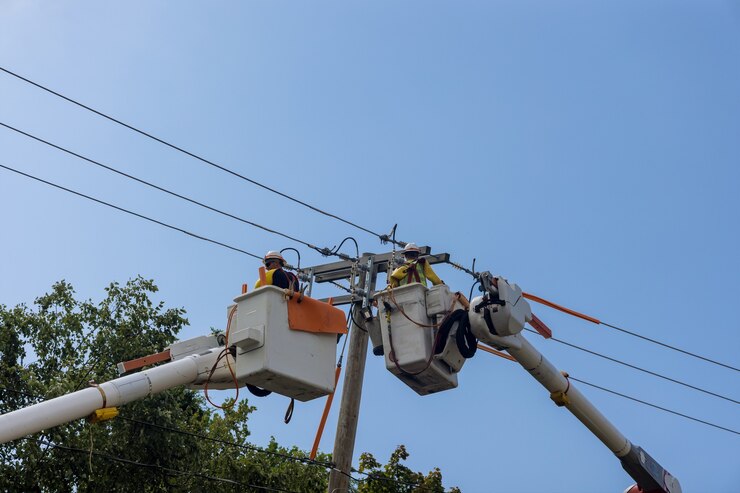Contatc
Best Practices for Maintaining Electrical Transmission Lines
2025-02-08
Best Practices for Maintaining Electrical Transmission Lines: Ensuring Reliability and Safety
The delivery of electrical power across extensive regions depends heavily on electrical transmission lines since they allow power to reach residential, industrial, and commercial establishments. Transmission lines operate at their best through routine maintenance due to their critical infrastructure status. This article contains information about best practices for maintaining electrical transmission lines approaches together with instructions regarding vegetation management insulator examination conductor upkeep and other essential facets.
Main Reason for Prioritizing Transmission Line Maintenance Activities
The workload that power transmission lines experience naturally causes degradation in their components with time. Serious disruptions leading to power outages or faults occur due to environmental factors that include wind, ice, and vegetation encroachment. The successful reduction of electrical disruptions depends on proper infrastructure maintenance together with the extension of system life expectancy and electrical grid dependability.
- The successful operation of electrical transmission lines depends on proper maintenance which needs to focus on the following main aspects:
- The network infrastructure faces severe weather threats because transmission lines encounter ice storms snowy conditions and high wind velocities.
- The components including towers and conductors with insulators experience deterioration because of corrosion together with structural aging processes.
- A power failure occurs when vegetation encroachment brings trees as well as other plant life into contact with transmission lines.
Veteran utilities should implement approved guidelines to stop these problems so utilities maintain stable electrical grids.
Key Best Practices for Maintaining Electrical Transmission Lines
Vegetation Management and Line Clearance
The main element in electrical transmission line maintenance involves vegetation management for stopping vegetation contact with power lines. The presence of vegetation around electrical lines produces the most frequent power breakdowns, particularly during stormy weather when trees bend towards the power lines and branches make contact.
Best Practices for Vegetation Management
- Aerial inspections should be conducted regularly to check the distance of trees and shrubs from the transmission lines.
- The practice of trimming branches along with pruning vegetation should happen to preserve a protective distance from power lines. Transmission line monitoring can be done through both drone systems alongside manual ground staff inspections.
- Clearing the right-of-way (ROW) surrounding power lines regularly will help prevent vegetation from growing near lines that pose an outage risk.
- Preventive measures consist of applying herbicides along with alternative methods to stop unwanted vegetation from reaching dangerous proximity to transmission lines.
- Electricity distribution becomes more secure through the use of thorough vegetation management plans that lower the frequency of tree-related power disruptions.

Insulator Inspection and Replacement
The essential role of insulators consists of interrupting electrical current from progressing through transmission towers and reaching the ground. Insulator inspections combined with routine replacements represent essential measures to stop power line faults because they avoid substantial power interruptions.
Best Practices for Insulator Maintenance:
- Insulator maintenance involves routine visual checks for detecting cracking as well as observing either wear or electrical tracking symptoms that can trigger outages.
- During the usage of infrared thermography technicians can identify problems through overheating which are strong indicator that insulator failures exist. The early identification of potential hazards becomes possible because of this method.
- A quick replacement protocol for insulators should be followed when deterioration signs appear to stop larger system failures.
- By maintaining an active practice of insulator inspections utilities achieve electrical transmission system security while ensuring operational reliability.
Conductor Maintenance: Repair, Replacement, and Tensioning
Electricity transmission lines consisting of conductors need regular maintenance to maintain their operational life. The inspection of conductors should focus on both material deterioration and ideal tension levels.
Best Practices for Conductor Maintenance:
- Transmission line conductors experience loosening due to time exposure. Proper tensioning of transmission lines ensures conductor bars remain stable in their position and minimize contact risks with surrounding objects.
- Exposure of conductors to environmental elements leads to corrosion throughout the process. The application of materials that fight against corrosion substantially increases operational life expectancy.
- System failure becomes inevitable if conductors display signs of damage so immediate repairs or replacements must happen immediately.
- The routine inspection of conductors makes it possible to stop power line failures that trigger extensive power interruptions.
Tower Inspection and Maintenance
Shifts and deterioration along with corrosion effects affect all components of transmission towers. Well-maintained transmission towers get their strength through regular inspections which keep them suitable to uphold the transmission lines.
Best Practices for Tower Maintenance:
- Drone-based monitoring alongside manual assessments should identify metal part rust and corrosion patterns because such damage weakens tower construction elements.
- Maintaining towers depends on regular protective coating applications followed by periodic painting procedures to avoid corrosion especially when towers are located around humid coastal regions.
- The integrity of bolts as well as clamps and hardware elements should receive systematic evaluation to confirm their proper functioning and intact condition. Towers require fast and immediate replacement of any loose or damaged parts.
- Maintaining towers both regularly and according to schedule stops potential system outages to keep electric service running.
The combination of all three maintenance approaches leads to peak performance along with reduced blackout risks during power delivery.
Transmission Line Services: Ensuring Reliable Power Delivery
XY Tower provides complete Transmission Line Services that include every step from design to construction and maintenance as well as the upgrading of high-voltage power lines. Our transmission activities prioritize vast-distance power delivery through the continuous application of modern technologies with selected high-quality materials which promotes optimal operational excellence.
- Our team performs periodic transmission line assessments to discover potential problems that enable prompt solutions that stop expensive operational interruptions. The proactive measures ensure uninterrupted and steady power delivery coupled with decreased possibilities of power blackouts.
- The service implementation aims at improving transmission line design practices and reducing infrastructure power loss while extending the operational lifetime of the equipment. Our team uses novel techniques along with superior materials to create long-lasting solutions that minimize power system operational expenses and raise system performance efficiency.
- Our transmission line services allow flexible solutions for future energy needs together with the integration of new emerging technologies. Our team of experts stands ready to support clients either in upgrading or performing full transmission line maintenance operations.
Contact XY Tower to receive dependable and cost-efficient transmission line services using forward-thinking solutions.
Conclusion
The best practices for maintaining electrical transmission lines involve a combination of proactive strategies, modern technologies, and adherence to regulatory standards. By implementing these practices—such as vegetation management, insulator inspection, conductor maintenance, and tower upkeep—utilities can ensure the safe and efficient operation of transmission systems. By prioritizing these best practices, utilities can reduce the risk of outages, enhance the reliability of the electrical grid, and contribute to a safer, more sustainable energy future. For more insights on transmission line maintenance and related services, visit XY Tower.

Hey, I’m Chunjian Shu
"X.Y. Tower: Reliable, innovative solutions for high-quality towers and electrical equipment with professional service.
